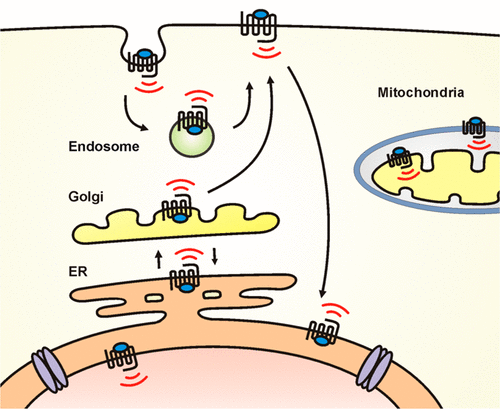当前位置:
X-MOL 学术
›
ACS Chem. Neurosci.
›
论文详情
Our official English website, www.x-mol.net, welcomes your
feedback! (Note: you will need to create a separate account there.)
Intracellular GPCRs Play Key Roles in Synaptic Plasticity.
ACS Chemical Neuroscience ( IF 4.1 ) Pub Date : 2018-02-16 , DOI: 10.1021/acschemneuro.7b00516 Yuh-Jiin I Jong 1 , Steven K Harmon 1 , Karen L O'Malley 1
ACS Chemical Neuroscience ( IF 4.1 ) Pub Date : 2018-02-16 , DOI: 10.1021/acschemneuro.7b00516 Yuh-Jiin I Jong 1 , Steven K Harmon 1 , Karen L O'Malley 1
Affiliation

|
The trillions of synaptic connections within the human brain are shaped by experience and neuronal activity, both of which underlie synaptic plasticity and ultimately learning and memory. G protein-coupled receptors (GPCRs) play key roles in synaptic plasticity by strengthening or weakening synapses and/or shaping dendritic spines. While most studies of synaptic plasticity have focused on cell surface receptors and their downstream signaling partners, emerging data point to a critical new role for the very same receptors to signal from inside the cell. Intracellular receptors have been localized to the nucleus, endoplasmic reticulum, lysosome, and mitochondria. From these intracellular positions, such receptors may couple to different signaling systems, display unique desensitization patterns, and/or show distinct patterns of subcellular distribution. Intracellular GPCRs can be activated at the cell surface, endocytosed, and transported to an intracellular site or simply activated in situ by de novo ligand synthesis, diffusion of permeable ligands, or active transport of non-permeable ligands. Current findings reinforce the notion that intracellular GPCRs play a dynamic role in synaptic plasticity and learning and memory. As new intracellular GPCR roles are defined, the need to selectively tailor agonists and/or antagonists to both intracellular and cell surface receptors may lead to the development of more effective therapeutic tools.
中文翻译:

细胞内 GPCR 在突触可塑性中发挥关键作用。
人脑内数万亿个突触连接是由经验和神经元活动塑造的,这两者都是突触可塑性以及最终学习和记忆的基础。G 蛋白偶联受体 (GPCR) 通过增强或削弱突触和/或塑造树突棘,在突触可塑性中发挥关键作用。虽然大多数突触可塑性研究都集中在细胞表面受体及其下游信号传导伴侣上,但新出现的数据表明,相同的受体在细胞内部发出信号方面发挥着关键的新作用。细胞内受体定位于细胞核、内质网、溶酶体和线粒体。从这些细胞内位置,此类受体可以与不同的信号系统偶联,表现出独特的脱敏模式,和/或表现出不同的亚细胞分布模式。细胞内 GPCR 可以在细胞表面激活、内吞并转运至细胞内位点,或者通过从头配体合成、可渗透性配体的扩散或非渗透性配体的主动转运简单地原位激活。目前的研究结果强化了细胞内 GPCR 在突触可塑性以及学习和记忆中发挥动态作用的观点。随着新的细胞内 GPCR 作用的确定,选择性地调整细胞内和细胞表面受体的激动剂和/或拮抗剂的需要可能会导致更有效的治疗工具的开发。
更新日期:2018-02-06
中文翻译:

细胞内 GPCR 在突触可塑性中发挥关键作用。
人脑内数万亿个突触连接是由经验和神经元活动塑造的,这两者都是突触可塑性以及最终学习和记忆的基础。G 蛋白偶联受体 (GPCR) 通过增强或削弱突触和/或塑造树突棘,在突触可塑性中发挥关键作用。虽然大多数突触可塑性研究都集中在细胞表面受体及其下游信号传导伴侣上,但新出现的数据表明,相同的受体在细胞内部发出信号方面发挥着关键的新作用。细胞内受体定位于细胞核、内质网、溶酶体和线粒体。从这些细胞内位置,此类受体可以与不同的信号系统偶联,表现出独特的脱敏模式,和/或表现出不同的亚细胞分布模式。细胞内 GPCR 可以在细胞表面激活、内吞并转运至细胞内位点,或者通过从头配体合成、可渗透性配体的扩散或非渗透性配体的主动转运简单地原位激活。目前的研究结果强化了细胞内 GPCR 在突触可塑性以及学习和记忆中发挥动态作用的观点。随着新的细胞内 GPCR 作用的确定,选择性地调整细胞内和细胞表面受体的激动剂和/或拮抗剂的需要可能会导致更有效的治疗工具的开发。











































 京公网安备 11010802027423号
京公网安备 11010802027423号